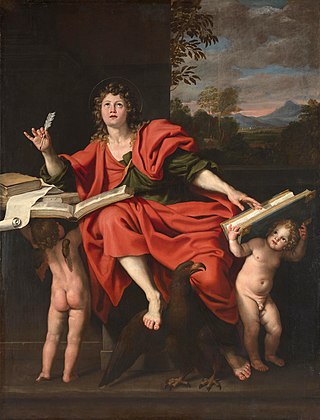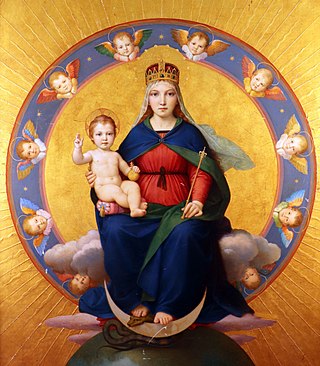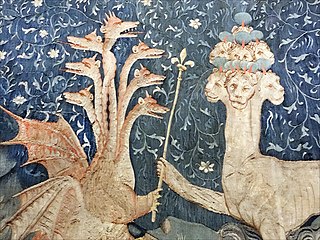
The Book of Revelation or Book of the Apocalypse is the final book of the New Testament. Written in Koine Greek, its title is derived from the first word of the text: apokalypsis, meaning 'unveiling' or 'revelation'. The Book of Revelation is the only apocalyptic book in the New Testament canon. It occupies a central place in Christian eschatology.
Christian eschatology is a minor branch of study within Christian theology which deals with the doctrine of the "last things", especially the Second Coming of Christ, or Parousia. Eschatology – the word derives from two Greek roots meaning "last" (ἔσχατος) and "study" (-λογία) – involves the study of "end things", whether of the end of an individual life, of the end of the age, of the end of the world, or of the nature of the Kingdom of God. Broadly speaking, Christian eschatology focuses on the ultimate destiny of individual souls and of the entire created order, based primarily upon biblical texts within the Old and New Testaments.

Preterism is a Christian eschatological view or belief that interprets some or all prophecies of the Bible as events which have already been fulfilled in history. This school of thought interprets the Book of Daniel as referring to events that happened from the seventh century BC until the first century AD, while seeing the prophecies of the Book of Revelation, as well as Christ's predictions within the Olivet Discourse, as events that happened in the first century AD. Preterism holds that Ancient Israel finds its continuation or fulfillment in the Christian church at the destruction of Jerusalem in AD 70.
In Christian eschatology, the Great Tribulation is a period mentioned by Jesus in the Olivet Discourse as a sign that would occur in the time of the end.

In the Book of Ezekiel in the Hebrew Bible, New Jerusalem is Ezekiel's prophetic vision of a city centered on the rebuilt Holy Temple, the Third Temple, to be established in Jerusalem, which would be the capital of the Messianic Kingdom, the meeting place of the twelve tribes of Israel, during the Messianic era. The prophecy is recorded by Ezekiel as having been received on Yom Kippur of the year 3372 of the Hebrew calendar.
Bible prophecy or biblical prophecy comprises the passages of the Bible that are claimed to reflect communications from God to humans through prophets. Christians usually consider the biblical prophets to have received revelations from God.

Saint Victorinus of Pettau was an Early Christian ecclesiastical writer who flourished about 270, and who was martyred during the persecutions of Emperor Diocletian. A Bishop of Poetovio in Pannonia, Victorinus is also known as Victorinus Petavionensis or Poetovionensis. Victorinus composed commentaries on various texts within the Christians' Holy Scriptures.
In Christian eschatology, historicism is a method of interpretation of biblical prophecies which associates symbols with historical persons, nations or events. The main primary texts of interest to Christian historicists include apocalyptic literature, such as the Book of Daniel and the Book of Revelation. It sees the prophecies of Daniel as being fulfilled throughout history, extending from the past through the present to the future. It is sometimes called the continuous historical view. Commentators have also applied historicist methods to ancient Jewish history, to the Roman Empire, to Islam, to the Papacy, to the Modern era, and to the end time.

Wormwood is a star or angel which appears in the Book of Revelation.

Babalon is a goddess found in the occult system of Thelema, which was established in 1904 with the writing of The Book of the Law by English author and occultist Aleister Crowley. The spelling of the name as "Babalon" was revealed to Crowley in The Vision and the Voice. Her name and imagery feature prominently in Crowley's "Liber Cheth vel Vallum Abiegni".

The Seventh-day Adventist Church holds a unique system of eschatological beliefs. Adventist eschatology, which is based on a historicist interpretation of prophecy, is characterised principally by the premillennial Second Coming of Christ. Traditionally, the church has taught that the Second Coming will be preceded by a global crisis with the Sabbath as a central issue. At Jesus' return, the righteous will be taken to heaven for one thousand years. After the millennium the unsaved cease to exist as they will be punished by annihilation while the saved will live on a recreated Earth for eternity.

The Woman of the Apocalypse is a figure–often considered to be a reference to the Virgin Mary in Catholic theology–described in Chapter 12 of the Book of Revelation.

The four kingdoms of Daniel are four kingdoms which, according to the Book of Daniel, precede the "end-times" and the "Kingdom of God".

The Beast may refer to one of three beasts described in the Book of Revelation.

John's vision of the Son of Man, also known as John’s Vision of Christ, is a vision described in the Book of Revelation in which the author, identified as John, sees a person he describes as one "like the Son of Man". The Son of Man is portrayed in this vision as having a robe with a golden sash, white hair, eyes like blazing fire, feet like bronze and a voice like rushing waters. He holds seven stars in his right hand and has a double-edged sword coming out of his mouth. The vision is interpreted by Christians as the only identifiable physical description of Jesus in any form in the Christian biblical canon.
Historicism is a method of interpretation in Christian eschatology which associates biblical prophecies with actual historical events and identifies symbolic beings with historical persons or societies; it has been applied to the Book of Revelation by many writers. The Historicist view follows a straight line of continuous fulfillment of prophecy which starts in Daniel's time and goes through John of Patmos' writing of the Book of Revelation all the way to the Second Coming of Jesus Christ.

Revelation 2 is the second chapter of the Book of Revelation or the Apocalypse of John in the New Testament of the Christian Bible. The book is traditionally attributed to John the Apostle, but the precise identity of the author remains a point of academic debate. This chapter contains messages to churches of Ephesus, Smyrna, Pergamum and Thyatira, four of the seven churches of Asia located in modern-day Turkey, with messages for the other three churches appearing in chapter 3.

Revelation 17 is the seventeenth chapter of the Book of Revelation or the Apocalypse to John in the New Testament of the Christian Bible. The book is traditionally attributed to John the Apostle, but the precise identity of the author remains a point of academic debate. This chapter describes the judgment of the Whore of Babylon.

Revelation 18 is the eighteenth chapter of the Book of Revelation or the Apocalypse of John in the New Testament of the Christian Bible. The book is traditionally attributed to John the Apostle, but the precise identity of the author remains a point of academic debate. This chapter describes the fall of Babylon the Great.

Revelation 19 is the nineteenth chapter of the Book of Revelation or the Apocalypse of John in the New Testament of the Christian Bible. The book is traditionally attributed to John the Apostle, but the precise identity of the author remains a point of academic debate. In this chapter, heaven exults over the fall of Babylon the Great.



















